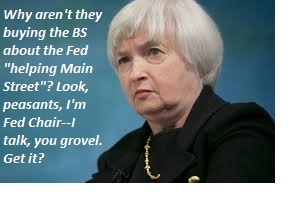The Insiders’ Case for a Stock Market Mini-Crash
by Charles Hugh Smith
The trade only works if everyone is lulled into staying on the long side until it’s too late.
Let’s try a thought experiment: suppose we’re players in the stock market, Wall Street insiders with real leverage and connections to the Fed. You know, the kind of player who can reverse a decline in the S&P 500 with an order (executed through a proxy) for thousands of call options on the SPX.
Retail participants tend to forget we make money on both the long and short side.The small-fry who provide liquidity always assume a sharp decline in equities is a terrible thing because “everybody is losing their gains,” and this general belief is pushed by the mainstream financial media: unfailingly chirpy news anchors’ expressions and voices darken when reporting the rare drop in stocks: horrible, horrible, horrible, a drop means we all lose, I’m sad reporting this.
The players are laughing at this play-acting and the gullibility of the audience: insiders make huge gains when they engineer a sharp decline. It’s not that difficult to manipulate the market when volume and volatility are low, especially in an age where quant-bot trading machines are programmed to follow trends.
It’s also easy to hype stocks publicly while selling (distributing) your shares at the top to unwary punters who believe the PR (the Fed has your back, thanks to the Fed’s quantitative easing (QE), the market will never go down, etc.).

But pushing the melt-up higher gets more difficult when the market gets heavy.Markets get heavy when participation thins (i.e. fewer stocks are leading the advance), speculative sectors are rolling over as the crowd of greater fools shrinks and volume on up days keeps declining.
When the markets get heavy, the easy-profits trade is get short and engineer a sharp decline. Nudging a heavy market into a free-fall has a number of advantages to players, other than the gratifying profits from being short equities and long volatility.

1. The Fed needs a decline to “prove” it isn’t pushing markets higher, further enriching the already obscenely rich. A thoroughly corrupted Congress is finally awakening to the public rage over the Federal Reserve’s blatant enrichment of the few at the expense of the many, and as a result, the Fed has a serious PR problem: Janet Yellen may be a lot of things, but a believable actress isn’t one of them. Her performance claiming the Fed acts only on behalf of widows, orphans, Mom, apple pie and the merchants lining Main Street was laughably inauthentic.
A sharp decline would demonstrate that the Fed isn’t controlling the market to enrich the insiders–even though a sharp decline would only benefit the insiders who engineered the drop. Heh. No need to be churlish about it. Where’s your sense of humor?
2. A mini-crash would panic the herd into selling, enabling insiders to scoop up shares on sale. This is of course the classic insider play: unload enough shares to blow off all the sell stops (i.e. orders to sell if price drops to specified level), which extends the decline and reinforces the panic-selling.
3. Never give a sucker an even break. After two years without a meaningful correction and complacency at multi-year highs, how much profit is there left in pushing an increasingly heavy market up another few percentage points? The big money is in engineering a decline that catches the crowd by surprise and doesn’t allow the traders a chance to board the short-bus before it roars out of the station.
Many traders are confident the market will broadcast a technical signal that will give them a chance to get on the short bus with the insiders. How likely is this? If we’re engineering a decline, why would we spoil the trade by letting a bunch of peasants get on board? With every quant-bot programmed to recognize all the usual technical signals and systems, why telegraph the trade?
As legendary stock trader/manipulator Jesse Livermore observed, the market will take the fewest possible number of participants along for the ride, and expecting the market to issue a “go short now for easy profits” signal would violate this rule: if everybody shifts from the long side to the short side, the trade is no longer profitable.
The trade only works if everyone is lulled into staying on the long side until it’s too late.Traders seem to be waiting for another standard-issue decline in September/October that would set up yet another standard-issue Santa Claus rally. Will it really be this easy to book profits in the second half? When everybody expects the same thing to unfold, it’s just another form of complacency.
Complacency–and the confidence that you can beat a confidence game by following what everybody else is following–is dangerous.
